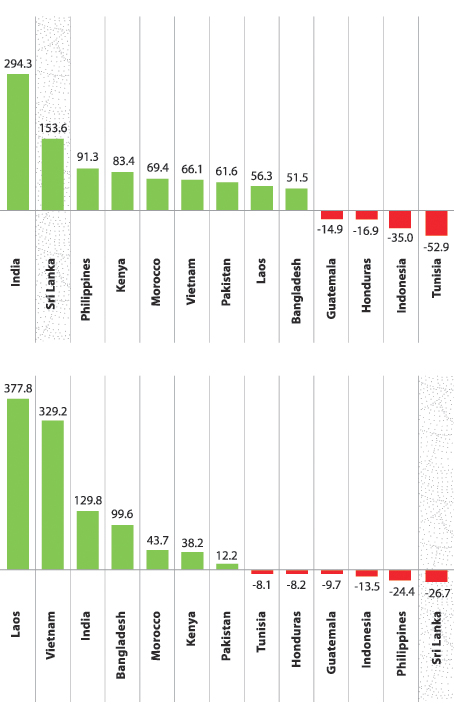IMF on protectionism: Stymies goods exports
|

Cross country comparison suggests Sri Lanka has effectively
gone backwards on trade protection - defying both regional
and global trends in policies and performance.
|
Creeping protectionism in the form of high import tariffs has led to
a decline in Sri Lanka's share of world trade in recent years, with
goods exports losing badly while, notably, the services sector, not
burdened with tariff and non-tariff barriers, has done much better, an
analysis by the International Monetary Fund has revealed.
Protection
While statutory Customs tariffs are relatively low, use of para-tariffs
and other trade taxes make the effective rate of protection considerably
higher, according to the IMF Staff Report released after the approval of
the US$1.5 billion IMF loan. This partly reflects the revenue problem,
as progressive use of border taxes somewhat compensated for weak VAT and
income tax, it said. Trade taxes currently in use are the Cess Levy,
Special Commodity Levy, and Port and Airport Development Levy, which
amounted to 1.4 percent of GDP in 2015 while import duties were 1.2
percent of GDP.
"Reviving Sri Lanka's outward orientation will also be essential to
achieving growth and other macroeconomic objectives," the IMF said.
"Sri Lanka's share in world trade has declined over the years."
War
While some of this was likely linked to increasing isolation and
lower productivity during the war, a second component seems to have been
a policy of "creeping protectionism and import substitution," it said.
Several of Sri Lanka's neighbours have performed more strongly in
this regard - managing to boost their share of global exports between
2000 and 2015.
"Notably, the services sector (which has been largely immune from
para tariffs, excises, and other forms of non-tariff barriers) has
performed much more strongly than goods exports in recent years,
mirroring the rise of services in the economy as a whole, and more than
keeping up with other lower middle income economies," the IMF said. – CJ
IMF report on SL trade
While statutory customs tariffs are relatively low, use of para-tariffs
and other trade taxes make the effective rate of protection considerably
higher. This partly reflects the revenue problem, as progressive use of
border taxes somewhat compensated for weak VAT and income tax.
Trade taxes currently in use are the Cess Levy, Special Commodity
Levy, and Port and Airport Development Levy, which amounted to 1.4
percent of GDP in 2015 while import duties were 1.2 percent of GDP.
World Bank estimates suggested that the average total nominal
protection rate as of 2011 was about 24 percent, with para-tariffs
amounting to 12 percent.
The imposition of these para-tariffs and other trade taxes are often
considered as complex and unpredictable, reducing transparency. Cross
country comparison suggests Sri Lanka has effectively gone backwards on
trade protection - defying both regional and global trends in policies
and performance.
Sri Lanka’s weaker trade performance points to the need of reforms.
Growth has not been driven by expanding exports and shifting to more
processed goods, but by domestic demand fueled by government spending
and inward remittances.
This reflects in Sri Lanka’s trade performance – both exports and
total trade as a share of world market declined over the 2000s and
stagnated in recent years (albeit with fluctuations). Lack of
integration and continued protection will only limit Sri Lanka’s growth
potential and undermine increased diversification and resilience to
external shocks.
Reviving Sri Lanka’s outward orientation will also be essential to
achieving growth and other macroeconomic objectives.
As noted above, Sri Lanka’s share in world trade has declined over
the years.
Some of this was likely linked to increasing isolation and lower
productivity during the civil war, but a second component seems to have
been a policy of creeping protectionism and import substitution.
Several of Sri Lanka’s neighbours have performed more strongly in
this regard - managing to boost their share of global exports between
2000 and 2015.
Notably, the services sector (which has been largely immune from para
tariffs, excises, and other forms of non-tariff barriers) has performed
much more strongly than goods exports in recent years, mirroring the
rise of services in the economy as a whole, and more than keeping up
with other lower middle income economies.
FDI remains relatively low, however, highlighting the cost of policy
uncertainty. |

